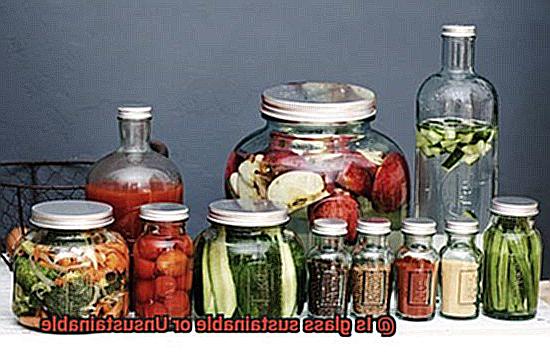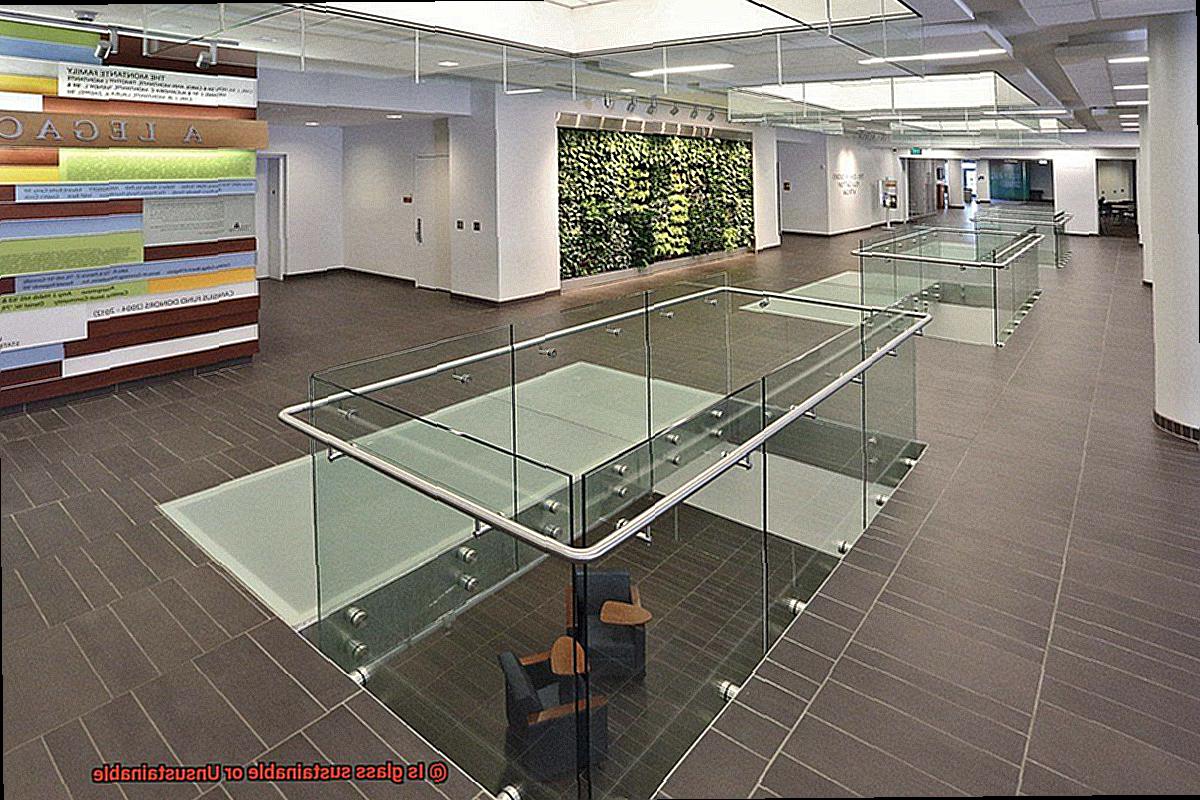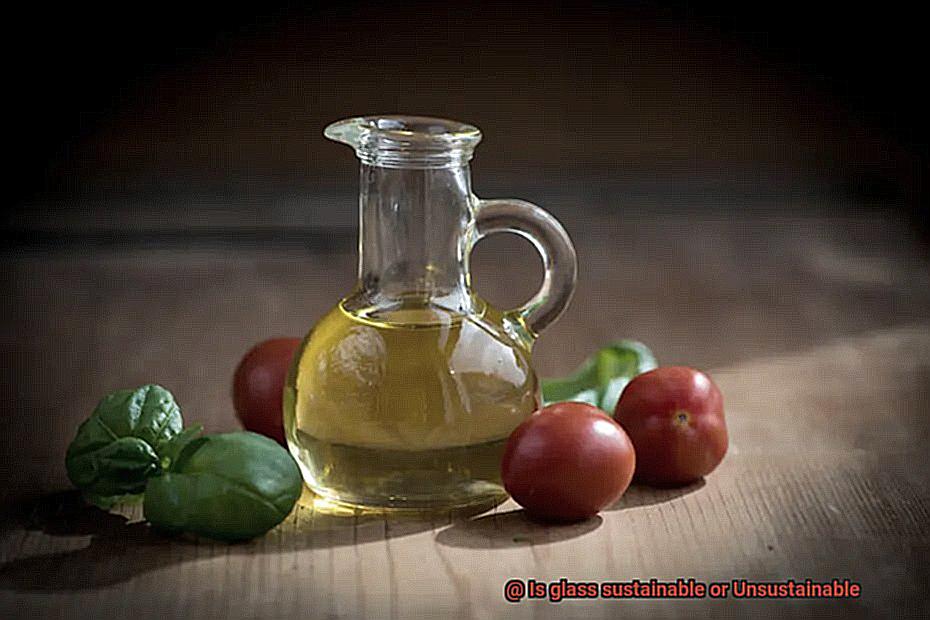Glass is everywhere around us, from the windows in our homes to the bottles we drink from. It’s a material that’s been used for centuries due to its versatility and durability. However, as we become more environmentally conscious, questions arise about whether glass is sustainable or unsustainable.
So, what’s the answer? Well, it’s not a simple one. In this blog post, we’ll dive deeper into the topic to give you a clearer understanding of where glass stands on the sustainability spectrum.
Firstly, let’s talk about how glass is made and its impact on the environment. The production process requires raw materials like sand, soda ash, and limestone that need significant amounts of energy to extract and refine. Plus, furnaces used in manufacturing emit harmful pollutants that contribute to air pollution. And don’t forget about transportation; glass products are heavy and bulky, adding more carbon emissions.
However, there’s another side to this story: Glass can be infinitely recycled. This is where its sustainability comes into play. By recycling glass instead of making new bottles or jars from virgin materials conserves resources and saves energy. Recycling just one glass bottle can power a light bulb for four hours.

So, whether or not glass is sustainable depends on how it’s used and disposed of properly. If produced responsibly and used efficiently with recycling in mind, it can be an eco-friendly material choice.
Let’s get started now.
Overview of Glass and Its Properties
Contents
Glass is an ancient material that has found its way into many different applications throughout human history, including construction, packaging, and transportation. This is because glass is a highly versatile and durable material that possesses unique properties, making it stand out from other materials.
One of the most notable properties of glass is its transparency. This quality makes it an ideal material for use in windows, mirrors, and other applications where visibility is essential. Additionally, glass is highly resistant to heat and chemicals, making it an excellent option for laboratories and other harsh environments.
Glass is made from natural raw materials like sand, soda ash, and limestone that are abundant in the earth’s crust. While the production process can be energy-intensive, the longevity of glass makes it a sustainable material choice in the long run. Glass is also one of the most recyclable materials on earth. It can be recycled indefinitely without losing quality or purity.

Recycling glass not only reduces waste but also conserves energy since recycling requires less energy than producing new glass from raw materials. By recycling just one ton of glass, up to 42 kWh of energy can be saved and greenhouse gas emissions can be reduced by up to 0.3 tons.

However, not all types of glass are easily recyclable. Tempered or laminated glass cannot be recycled as easily as regular glass. Additionally, when not recycled or repurposed properly, glass can take hundreds or even thousands of years to break down in a landfill.
The key takeaway is that while the production and transportation of glass do have environmental impacts, its recyclability and longevity make it a sustainable material choice when used and disposed of correctly. By recycling glass products and repurposing them into new forms or products, we can contribute to a circular economy where resources are reused and kept in the system rather than being discarded as waste.
Production Process of Glass
Glass is a versatile and fascinating material that has been used for centuries in various applications such as building construction, tableware, and laboratory equipment. But have you ever wondered about the production process of glass and how it contributes to sustainability? Let’s dive into the production process of glass and explore its environmental benefits.
The first step in glass production is gathering the raw materials such as silica sand, soda ash, limestone, and other additives. These materials are mixed together and heated in a furnace until they become molten glass. The molten glass is then shaped into the desired form using techniques like blowing or molding. After that, the glass undergoes a cooling process to harden and become strong enough for use.
Though the production process of glass involves high temperatures and energy consumption, it is still considered a sustainable material. This is because glass is made from natural raw materials that are abundant and easily accessible. Furthermore, glass is 100% recyclable, meaning it can be endlessly recycled without losing its quality or characteristics.
Recycling glass offers several environmental benefits. It reduces the amount of waste in landfills, conserves natural resources by reducing the need for new raw materials, and saves energy since recycled glass requires less energy to melt than virgin glass. Glass recycling also helps reduce greenhouse gas emissions since it produces fewer emissions during the manufacturing process than producing new glass.
Transportation Impact of Glass Products
Glass products are not only beautiful, but they are also environmentally friendly. However, transportation is an essential factor to consider when determining the sustainability of glass products. The transportation of glass products can significantly contribute to greenhouse gas emissions and other negative environmental impacts. In this blog post, we will explore how manufacturers can reduce the transportation impact of glass products.
The distance that glass products need to travel is one of the main factors affecting their transportation impact. If glass products are manufactured and sold locally, transportation can be minimized, and their impact reduced. However, if glass products need to be transported long distances, this can increase their overall environmental impact. Therefore, it is essential to consider the location of the manufacturing plant and the target market.
In addition to distance, the mode of transportation also affects the sustainability of glass products. Transporting glass by truck or plane may have a higher environmental impact than transporting it by train or ship, which are generally more fuel-efficient. By choosing more sustainable modes of transportation and optimizing the logistics in the supply chain, manufacturers can significantly reduce the carbon footprint of their products.
To minimize the transportation impact of glass products, some manufacturers have implemented sustainable strategies such as using local raw materials. For instance, using sand from nearby sources for glass production reduces both transportation and energy costs. Manufacturers may also choose to use more sustainable modes of transportation such as trains or ships rather than trucks or planes.
Glass is a sustainable material that can be endlessly recycled without losing its quality or characteristics. Recycling glass not only reduces waste in landfills but also conserves natural resources by reducing the need for new raw materials while saving energy since recycled glass requires less energy to melt than virgin glass. By implementing sustainable transportation strategies, manufacturers can make glass even more environmentally friendly.
Recycling Benefits of Glass
Glass is a truly remarkable material that offers numerous benefits to our planet, and one of the most significant is its ability to be recycled indefinitely without losing quality or purity. The recycling benefits of glass cannot be overstated, and in this section, we will explore how recycling glass can help us create a more sustainable future.
Using recycled glass in the manufacturing process has multiple advantages. It reduces the need for virgin raw materials, conserves energy, and minimizes carbon emissions. This means that by recycling glass, we can preserve natural resources, reduce pollution, and combat climate change. What’s more, recycling glass creates job opportunities in the recycling and manufacturing industries, leading to economic benefits for communities.
Recycling glass also reduces the amount of waste that ends up in landfills, which is excellent news for our planet. Glass is one of the most commonly recycled materials worldwide, with around 33% of all glass containers being recycled. The recycling process involves collecting used glass containers, cleaning and sorting them by color, and crushing them into small pieces called cullet.
The cullet can then be used in the manufacturing process to create new glass products. For every ton of cullet used in the manufacturing process, around 1.2 tons of raw materials are conserved, and energy consumption is reduced by approximately 30%. This means that by recycling glass, we not only conserve natural resources but also significantly reduce energy consumption.
Types of Glass that Cannot be Recycled Easily
While glass is known for its infinite recyclability, there are certain types that can pose challenges for recycling facilities.
Let’s start with tempered glass. This type of glass is incredibly strong and is commonly used in car windows, shower doors, and other applications where safety is crucial. However, the rapid cooling process used to create tempered glass makes it prone to shattering into tiny pieces when broken. These small pieces can contaminate the recycling process and make it difficult to separate the tempered glass from other materials.
Another type that can be tricky to recycle is colored glass. While clear glass can be easily sorted and recycled back into new clear glass products, colored glass presents a challenge because it requires sorting by color before it can be recycled. This extra step adds complexity and cost to the recycling process, and some facilities may not have the capability to sort colored glass.
Lastly, any glass product that has been treated with a special coating or chemical can also be difficult to recycle. For instance, some heat-resistant glasses used in cooking or laboratory settings have been treated with a special coating that makes them resistant to high temperatures. This coating can interfere with the recycling process and make it difficult to separate the glass from other materials.
It’s important to keep in mind that while these types of glass may present challenges for recycling facilities, most types of glass are still highly recyclable and sustainable. We can all do our part by being mindful of the types of glass we use and ensuring that we dispose of them properly so they have the best chance of being recycled.
Disposal Considerations for Glass
Glass is a true champion of sustainability. It’s a 100% recyclable material that can be recycled endlessly without losing its quality or purity, making it an environmentally friendly option for disposal. Glass recycling is a crucial part of the circular economy, which aims to minimize waste and reduce our reliance on virgin materials.
Proper disposal methods are important for glass to be recycled in a closed-loop process. This involves collecting, sorting, cleaning, crushing, and melting down the glass to create new products. By doing so, we save energy, reduce greenhouse gas emissions, conserve natural resources, and decrease the amount of space needed for landfills. Landfills are notorious for emitting methane, a potent greenhouse gas that contributes to climate change.
To dispose of glass correctly, it should be placed in designated recycling bins or taken to a local recycling center. However, not all types of glass can be recycled together. For instance, Pyrex or ceramic glass cannot be recycled with regular glass as they have different melting points and chemical compositions. Therefore, it’s crucial to separate them and recycle them separately to ensure that they don’t contaminate the recycling process.
3roITeXVWuE” >
Conclusion
To sum up, glass is a remarkable material that has been utilized for centuries due to its versatility and durability. However, as our society becomes more environmentally aware, we must ask ourselves if glass is sustainable or not. The answer isn’t black and white; it depends on how it’s produced, transported, used, and disposed of.
The production of glass necessitates raw materials that demand significant amounts of energy to extract and refine. Furthermore, the transportation of glass products can contribute significantly to greenhouse gas emissions. Nevertheless, glass can be recycled indefinitely without losing its quality or purity. Recycling glass conserves resources and saves energy by avoiding the need to create new bottles or jars from virgin materials.
Recycling one ton of glass can save up to 42 kWh of energy while reducing greenhouse gas emissions by up to 0.3 tons. Unfortunately, some types of glass like tempered or laminated glass aren’t easily recyclable. Additionally, when not recycled or repurposed properly, glass can take hundreds or even thousands of years to decompose in a landfill.
As a result, it’s crucial to dispose of glass correctly by placing it in designated recycling bins or taking it to a local recycling center. By doing so, we can contribute to a circular economy where resources are reused instead of being thrown away as waste.





